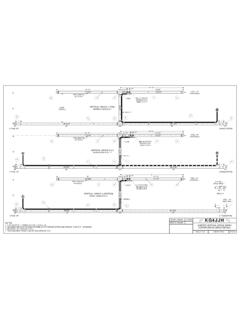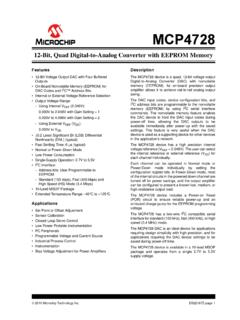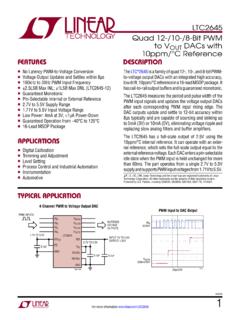Transcription of Vocal Keyer - KG4JJH
1 Vocal Keyer Build this stand-alone contesting accessory for your radio and conserve your voice T he June 2008 VHF contest provided a golden opportunity to try my newly assembled Elecraft 222 MHz transverter and homebrew Yagi. The equipment performed well but points for this band were hard to get as repeated CQs over the contest period netted a raspy voice and only five contacts. After the contest I began looking at commercially available voice keyers to take the brunt of calling CQ. Most keyers are now of the PC soundcard variety but I wanted the ability to operate without a computer.
2 Searching the internet I found an assortment of voice recording chips. The HK8281 caught my eye with claims of multiple messages and an 8 KHz sample rate. Unlike the popular ChipCorder devices by ISD, this chip can be easily configured for 2, 4, or 8 fixed duration messages without a microcontroller. I ordered the required components and bread-boarded the circuit. A printed circuit board was then developed and the assembled board was mounted in a small enclosure. Connection to my Yaesu FT-857 was made using a short CAT-5 cable.
3 The Keyer was built with all new parts for about $75 and boasts the following features: Two 16-second messages with an 8 KHz sample rate and 4 KHz bandwidth (or four 10- second messages with a KHz sample rate and KHz bandwidth). Built-in audio amplifier and speaker Message pushbuttons Play/Record switch & LED. Transmit On/Off switch Uses the radio microphone Transformer isolated audio output with level control and automatic PTT switching Message-1 repeat with 2-25 second delay interval Suitable for any radio with appropriate RJ-45 adapters for the microphone and radio Circuit Description The HK828 provides high quality, single-chip record and playback for 32-60 second messaging applications.
4 The device includes an oscillator, microphone preamp, automatic gain control, anti- aliasing filter, smoothing filter, speaker amplifier, and a high density multi-level storage array. Recordings are stored in nonvolatile memory which provides zero power message storage. Vocal Keyer , KG4 JJH Page 1 of 6. Controls All user controls are accessible from the front panel. Audio volume and power is controlled by potentiometer R18 (VOL) with integral switch that turns on DS1 (PWR) when power is applied. The transmit level sent to the radio is set by potentiometer R17 (XMT LVL).
5 Potentiometer R19. (DELAY) sets the time interval between MSG1 repeats. Momentary pushbuttons S1 and S2. provide recording and playback of MSG1 and MSG2, respectively. Locking pushbutton S3. selects between PLAY and REC, and switches the microphone input to U1 or to the radio. Locking pushbutton S4 allows message monitoring without transmitting (XMT ON/OFF). Red LED DS2 flashes when recording or playing messages. U1, HK828. The sampling rate determines voice quality and is set by the sampling clock oscillator frequency resistor (See Table 1): Sampling Input Recording Number OscR MSEL1 MSEL2.
6 Frequency Bandwidth Time of (R6) (Pin 24) (Pin 25). (KHz) (KHz) (Seconds) Messages 84K 60 8 +5V +5V. 38K 40 4 +5V Ground 24K 32 2 Ground +5V. Table 1. Random access mode can be configured for 2, 4, or 8 fixed length messages by tying the MESL1. and MSEL2 pins high or low. Since most radios have an audio bandwidth of to 3 KHz, the two highest sampling rates should be used to ensure good audio fidelity. Each message length is equal to the total recording time divided by the number of messages. For this project R6 is 24K.
7 Ohms which yields a sampling rate of 8 KHz and 32 seconds of recording time. Random access mode for two 16-second messages is achieved by tying pin 24 (MSEL1) low and pin 25. (MSEL2) high. For slightly less voice quality change R6 to 38K, tie pin 24 high and pin 25 low, resulting in four 10-second messages. Two additional SPST momentary pushbuttons on pins 3. and 4 will then control messages 3 and 4. Solder jumper JP1 across the ON pads to enable the message beep function or across the OFF pads disable the beep.
8 The addition of a built-in electret microphone is simple and inexpensive and is documented on the HK828 datasheet. However, when a microphone element is soldered to the PC board it picks up all noises including pushbutton actuations. For this reason, and to simplify the design, the decision was made to use the radio microphone. U2, Monostable Multivibrator MC14538B. The MC14538B is a dual monostable multivibrator or one-shot. Triggering can occur from either the rising or falling edge of an input pulse, resulting in an output pulse over a wide range of widths.
9 Pulse duration and accuracy are determined by external timing components on the RxCx pins. The pulse width in seconds is equal to R*C, where R is in ohms and C is in Farads. Vocal Keyer , KG4 JJH Page 2 of 6. The Busy signal from U1 provides a low-going pulse during message recording and playback. This pulse is inverted by U4D and fed to U2A to provide the trigger for the time delay between messages. The end of the delay output pulse from U2A triggers U2B to provide a second low-going pulse that restarts MSG1.
10 Diode D3 protects the chip from power-down transients when using large capacitors. U3, Power Amplifier LM386. The speaker output on U1 provides 12mW into a 16 load. I found this power level to be inadequate so U3 was added to boost the level to watt. The amplified audio signal is then sent to an 8 speaker. U4, Quad NOR Gate CD40001. NOR gates U4B and U4C are configured as a Set-Reset latch2 and control the message repeat in conjunction with the MSG1 pushbutton and microphone PTT switch. When the MSG1. pushbutton is pressed the latch Reset line is pulsed high which forces the Q output high and enables the U2 delay interval.







